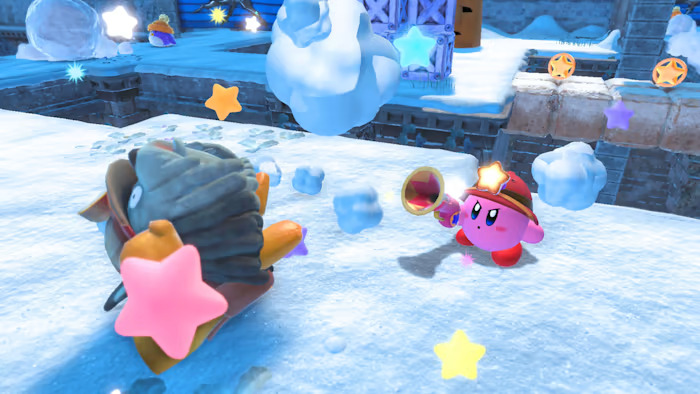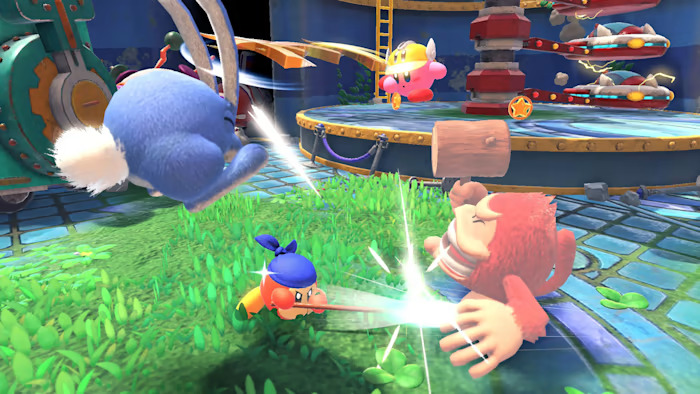“Kirby and the Forgotten Land is a charming platformer filled with intuitive puzzles, a genuinely intriguing world, and hysterical transformations that always made me smile.”
- Hilarious Mouthful Mode
- Mysterious world
- Neat ability upgrades
- Waddle Dee Town is quaint
- Runs out of ideas
- Co-op play is limited
Is there any video game series as joyful as Kirby? The second I booted Kirby and the Forgotten Land up for the first time, I broke out into a cheerful grin. After a month spent exploring post-apocalyptic wastelands, I was happy to watch the pink puffball pitter-patter around colorful landscapes without a care in the world.
Hilariously, Kirby and the Forgotten Land actually is a post-apocalyptic game. Kirby is sucked into another world filled with decaying shopping malls and abandoned amusement parks from a seemingly dead civilization. Its world actually isn’t too far off from that of Horizon Forbidden West, just swapping robots for dastardly foxes. The difference is that the setting doesn’t stop Kirby from treating it like his own personal playground — and buffet.
Kirby and the Forgotten Land is an adorable platformer cut from the same cloth as Nintendo’s finest. The game’s absurd Mouthful Mode is an especially strong gimmick that lets developer Hal Laboratory get more playful and comedic with the series. It loses some steam when it runs out of ideas, but its story and levels never fail to charm me.
All you can eat
Kirby and the Forgotten Land is the first 3D Kirby game since the Nintendo 64’s Kirby 64: The Crystal Shards, but it’s not a radical reinvention of the series. It still very much feels like a traditional 2D Kirby game and that’s a good thing. Kirby has always been a secret weapon in Nintendo’s first-party arsenal, providing smooth puzzle-platforming that’s easy on the brain. That’s exactly what you get here, with the game sharing more similarities to Super Mario 3D World than Super Mario Odyssey.
As always, the game is built around Kirby’s insatiable appetite. He can suck up enemies to gain new powers, like fire breath, bombs, or the ability to take a long nap (my favorite). Those can be used during linear platforming levels to solve puzzles that require using the right ability. See something tangled up in a vine? Grab a sword or cutter to chop it down. Each level is filled with intuitive micro-puzzles like that. They’re never hard to figure out, but always satisfying to execute.

There’s added depth to that formula this time thanks to Mouthful Mode, which allows Kirby to suck up gigantic objects to comedic effect. If Kirby sucks up a vending machine, he becomes a big pink rectangle that can shoot soda cans out of his mouth. I laughed at every single one without fail.
It’s not just a hysterical visual though; it’s a practical mechanic too. It lets the game create puzzles that aren’t just built around using a single ability. In one room, I need to light a fuse using fire power and get to a canon in time. However, there’s a staircase sitting on the rope, which extinguishes the flame. I need to light it, become the staircase (which is an unbelievably funny visual), and make my way around the fuse as it burns down. Then, I need to get the staircase into a position that allows me to climb my way up to the canon in time. It’s a clever little song and dance that tests my ability to juggle two abilities at once.
The main story is a hit of classic Nintendo fun that checks all the right boxes.
Kirby has needed a system like this for a while. When I played the comparatively underwhelming Kirby Star Allies, I felt like I had done all of its puzzles before in some form, even with its added multiplayer focus. The simplest fuse lighting feels fresher here – and much funnier, to boot.
Clocking in at around eight hours, the main story is a hit of classic Nintendo fun that checks all the right boxes. Solid bosses, well-hidden secrets, and tons of collectibles round the core package out to make this feel like the kind of Nintendo game you grew up loving. Fun doesn’t have to be fancy.
Lost in the supermarket
What makes Kirby and the Forgotten Land particularly stand out among a sea of platformers is its world. In something like a 2D Mario game, levels can feel a little random. They’re built around a gameplay motif first and foremost, so it rarely feels like you’re walking around an actual cohesive world. By contrast, the titular Forgotten Land actually feels like a sensical space with its own secret history.
When I enter the obligatory “ice world,” it’s not just a random collection of cold, linear paths. I’m walking through abandoned city streets and fighting bosses on a massive, frozen suspension bridge. What did this city used to be? There’s a continuity to the world that makes me actually want to know about it, not just bounce around it.
Even with all of its dilapidated buildings, the art direction radiates joy.
I get little bits and pieces of that story, but the game lets me stay curious. There are collectible gachapon toys that give little snippets of flavor text, teasing the apocalypse that took place. One figurine of a billboard tells me about an energy mega power that split up, leading to “countless heated corporate battles.” Had I stumbled into a world where an ExxonMobil-like company caused the downfall of humanity?
I love that I never fully get that answer. Kirby and the Forgotten Land reminds me of a Hayao Miyazaki film in that way. What I’ve always loved about Ponyo, for instance, is that there’s some sort of apocalyptic event happening in the background, but it’s treated like a B-plot. Instead, the film spends most of its time watching its heroes joyfully eat ham as if nothing is happening. There’s room for peace amid the hysteria, and that’s how I feel when I see Kirby doing his little dance every time he clears a level.

Even with all of its dilapidated buildings, the art direction radiates joy. The colors are so pleasant that I couldn’t care less about whether or not the Switch can run 4K visuals. When Kirby swallows an entire car, the animation plays out with a kind of slapstick charm that takes me back to the days of watching Cartoon Network. Even the sound design, like the plastic scuttling of Kirby’s red shoes, gets a rise out of me.
In a high anxiety time where it feels like the Forgotten Land could become a preview of our own world, Kirby is the pink stress ball I need.
The escalation challenge
There’s a surprising amount of content packed into the package, though it has its limits. The game’s main sin is that it runs out of ideas halfway through the main story. I collected every copy ability and saw almost every Mouthful Mode by world four. After that, I found myself fighting a lot of the same bosses and doing variations on the same puzzles until the end.
Kirby and the Forgotten Land ultimately has an escalation problem. When you write a comedy sketch, you always need to heighten the gag until the very end. You can’t tell your best joke in the first few minutes, but that’s what happens here. The game is at its best when it’s serving up new powers, bosses, and laughs. It runs out of those eventually, leaving it looking like a stand-up comedian who just got asked to fill another 20 minutes they weren’t prepared for.

The game does have a few workarounds for its eventual content stall. The best among them is a power upgrade system, which lets Kirby buff his copy abilities. They don’t just get stronger; they become entirely new tools. When the traditional ice breath ability morphs, Kirby can use his breath to build snowmen and slide them over to an enemy. The drilling ability, that lets Kirby burrow underground, turns into a giant pencil that launches at enemies. That system triples the number of powers in the game and adds a sense of progression when everything else starts slowing down.
Waddle Dee Town, the game’s hub world that expands as Kirby saves more Waddle Dee, adds some needed variety. While it’s small, it contains a handful of simple minigames to cut through the repetition. Kirby can fish, play a ball-rolling game that uses the Switch’s gyroscopic controls, and more. Most of the side activities are simple and can be fully “completed” in a few minutes, but it’s a nice excuse to relax in a quaint space and listen to some tunes.
I collected every copy ability and saw almost every Mouthful Mode by world four.
There’s a multiplayer option too, but it’s a bit of a missed opportunity. Player two is very much a typical “player two” here. While Kirby gets to eat everything in sight, his co-op partner is a spear-wielding Waddle Dee with a few unique attacks. The camera is shared between both and only tracks Kirby, so it’s very much a sidekick role. With no online option available, it’s only something that’ll really benefit parents and their kids.
Even with its repetitive late game, I still enjoyed just about every second of Kirby and the Forgotten Land. In the game’s opening sequence, Kirby swallows a car and rides down a highway as a pop tune plays. In one shot, he’s cruising against the clear blue sky as some seagulls fly by his window. That’s how I felt whenever I booted it up: Head empty, soaking in the sunshine, not a care in the world.
Our take
Kirby and the Forgotten Land is a delightful puzzle-platformer that adds more dimensions to the basic Kirby formula. Mouthful Mode isn’t just a gimmick; it’s a hysterical mechanic that deepens the puzzle potential. The art direction is the star of the show, turning basic platforming motifs into a creative world that always had me curious to see what awaited me in the next level. The game stalls out once it stops presenting absurd new transformations, but features like Waddle Dee Town and ability upgrading give it some extra oomph during repetitive moments. It’s a warm spring breeze for Switch owners.
Is there a better alternative?
Super Mario Odyssey has a similar mechanic within a more robust game. Though Kirby and the Forgotten Land is a notable improvement over the pink puffball’s last Switch outing, Kirby Star Allies.
How long will it last?
The main story will take around eight to 10 hours to complete. There’s a ton to collect and lots of side activities too, which will likely double that time. I’m at 90% completion after 15 hours.
Should you buy it?
Yes. This is the best Kirby game since the Nintendo 3DS’ Kirby: Planet Robobot and a wonderful Switch game for kids (and the young at heart).
Kirby and the Forgotten Land was tested on a Nintendo Switch OLED in handheld mode and on a TCL 6-Series R635 when docked.





